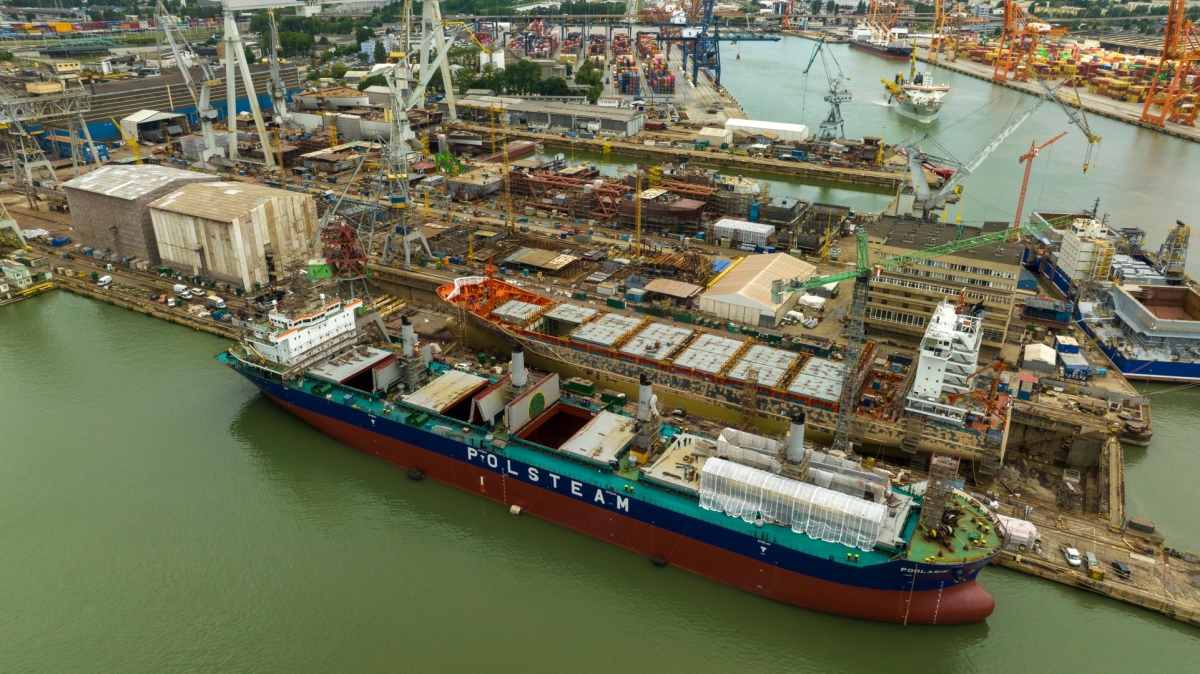
In our discussion with Monika Kozakiewicz, the CEO of Nauta Shiprepair Yard, we delve into strategic milestones, external partnerships, and the vision for the shipyard's evolution. Witha flexible operational model and ongoing modernization plans, the company is shapinga sustainable future and adapting to regulations, environmental considerations and market expectations.
As Nauta Shiprepair Yard approaches the centenary of its existence, can we begin to draw preliminary conclusions? Could you highlight key stages of development and pivotal moments in the company's history? What, in your retrospective view, appears to be particularly significant?
Over the course of nearly 97 years in operation, we have experienced two pivotal stages of development. The first was during our time on Washington Street in Gdynia, where limited territorial space constrained our growth. The second stage followed our move to the former Gdynia Shipyard premises, where Nauta Shiprepair Yard gained access to a larger area and, notably, the SD-I dry dock. This move significantly expanded our production capabilities, allowing us to undertake large-scale ship repair projects. Currently, we are capable of conducting dry dock repairs on ships of the kamsarmax type. Furthermore, changes in our business model led to the establishment of subsidiary companies and the reorganization of our production processes. Presently, the shipyard employs approximately 300 permanent staff, with an additional 300 employees in our subsidiary companies. Additionally, around 1,500 people from external companies work on our projects, making us a major player in the regional labor market.
What are the advantages of implementing a business model based on a parent company and subsidiaries?
This model offers several advantages, primarily related to cost efficiency and organizational flexibility. The shipyard is susceptible to seasonal fluctuations in production capacity. Spring and summer witness intensive ship repairs, while the winter period experiences reduced demand. The operational model allows us to efficiently adapt to changing market conditions. The transformation of our organizational structure was therefore pivotal in achieving improved efficiency and competitiveness in the ship repair market.
What were the results and effectiveness of the shipyard in the past year and the first half of the current year? What were the operating revenue figures, and how many projects were completed?
We achieved remarkable milestones in the past year, making it a record-breaking year for our shipyard. Our operating revenue reached an impressive 319 million Polish złoty. In 2022, we completed over 154 projects, focusing primarily on class repairs, intermediate repairs, and the installation of BWTS (Ballast Water Treatment Systems). Our main markets are Germany, Norway and Poland. In the current year, despite conducting class repairs on two of our floating docks, we continue to observe a strong performance. We are persisting with class repairs and BWTS installations. It is worth noting the growing interest from shipowners in conversion and vessel conversion projects, signaling their confidence in our capabilities. In the past, the shipyard successfully executed numerous ship extensions, and we anticipate that we will have the opportunity to undertake more complex projects for our clients.
Could you provide an update on the progress of the acquisition of the SD-I dry dock? Are there plans for further infrastructure development at the shipyard, such as acquiring a larger floating dock?
Thus far, we have been leasing the SD-I dock, and we are currently in the process of acquiring it from its current owner, the Industrial Development Agency. We anticipate finalizing this transaction in early autumn. It is crucial to highlight that one third of our revenue comes from activities related to SD-I, emphasizing the dock's vital importance to Nauta Shiprepair Yard. Presently, we operate on infrastructure initially built for Gdynia Shipyard, which is now a century old. Given its age and historical significance, this infrastructure requires continuous investment and modernization, which we are actively pursuing. Given our geographical constraints—operating within the boundaries of Gdynia Maritime Port—we are unable to rely on access to additional quaysides. Therefore, the modernization of our existing infrastructure is necessary to enhance its efficiency. Additionally, our plans include the consideration of a larger floating dock, possibly even a covered one, to meet new environmental protection standards and provide better working conditions. We are also exploring modern automation equipment options to expedite and streamline our projects. These developments will undoubtedly open new possibilities for our shipyard and solidify our position in the market.
How does collaboration with external companies impact the shipyard's operations and the local economy?
Collaboration with external companies holds paramount importance for our shipyard and the local region. As mentioned earlier, up to 1,500 employees from local businesses work on our premises, making a significant contribution to the projects we undertake. As an employer for local companies, we contribute to the economic growth of the Pomeranian region. We collaborate with companies specializing in various fields, such as engine repairs, pipe installations, electrical work, and machining. Although we have our subsidiary companies with expertise in these areas, market dynamics create a demand for greater production capacity than our subsidiaries can provide.
What are the long-term prospects for the shipyard in light of regulatory changes, environmental requirements, and rising customer expectations?
Indeed, as we approach our centenary, it prompts us to reflect on continued development to align with new challenges and the evolving expectations of our environment. Changes in regulatory landscapes, including heightened environmental requirements for both the shipyard and our clients, necessitate ongoing adaptation. Close collaboration with our customers and shipowners, and responsiveness to their needs are essential for a sustainable future. The essence of repair activity lies in flexible responses to sudden customer needs, and I am confident that, as an organization, we will adapt to the changes that await the maritime industry and the industrial sector as a whole.


